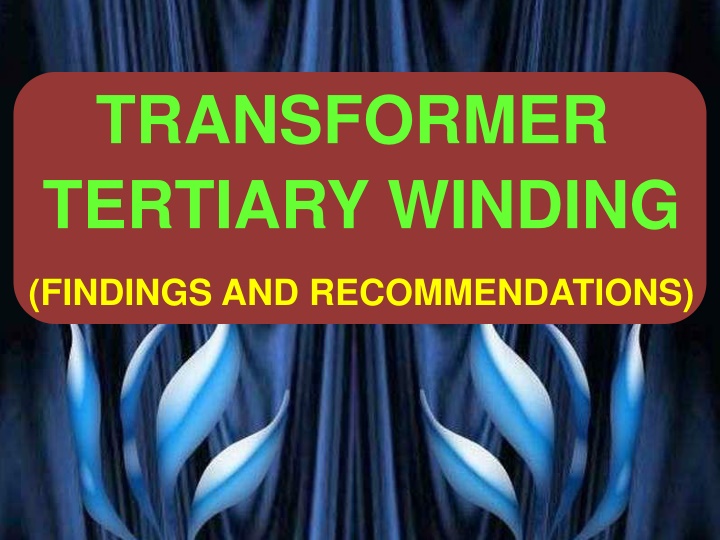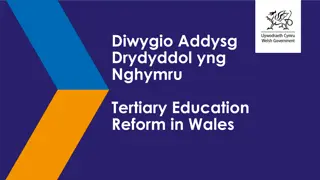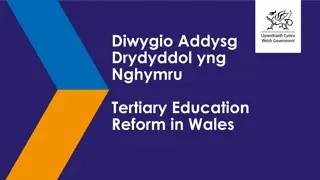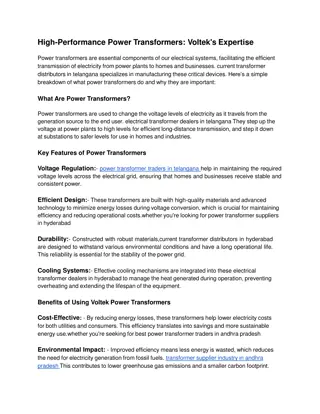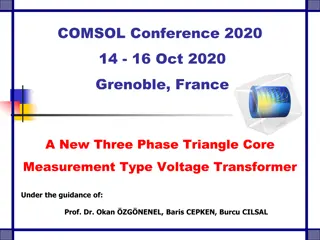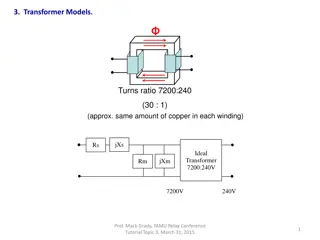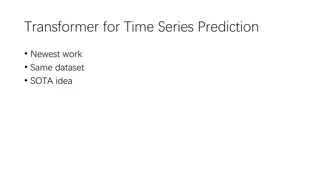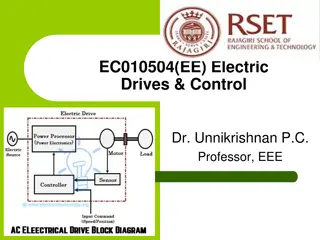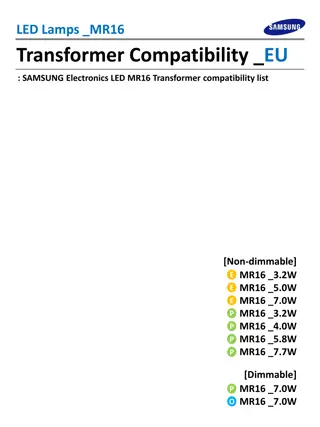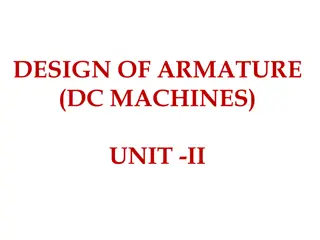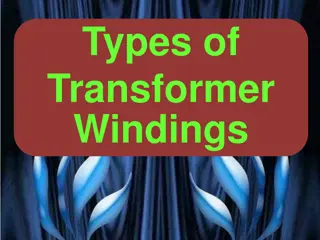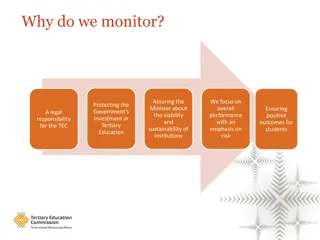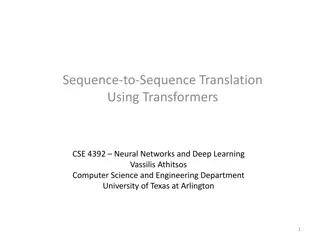Transformer Tertiary Windings
Tertiary windings in transformers play a crucial role in stabilizing voltages, controlling impedance, and mitigating harmonic effects. Learn about the functions and benefits of tertiary and stabilizing windings in transformers.
Download Presentation

Please find below an Image/Link to download the presentation.
The content on the website is provided AS IS for your information and personal use only. It may not be sold, licensed, or shared on other websites without obtaining consent from the author.If you encounter any issues during the download, it is possible that the publisher has removed the file from their server.
You are allowed to download the files provided on this website for personal or commercial use, subject to the condition that they are used lawfully. All files are the property of their respective owners.
The content on the website is provided AS IS for your information and personal use only. It may not be sold, licensed, or shared on other websites without obtaining consent from the author.
E N D
Presentation Transcript
TRANSFORMER TERTIARY WINDING (FINDINGS AND RECOMMENDATIONS) VG PATEL
TRANSFORMER ENCYCLOPAEDIA TERTIARY WINDING TRANSFORMER TERTIARY WINDING (FINDINGS AND RECOMMENDATIONS) Monday, March 10, 2025 2 PROF. V. G. PATEL
TRANSFORMER ENCYCLOPAEDIA TERTIARY WINDING What is the function of tertiary and stabilizing tertiary windings in a Transformer? Tertiary Winding: An additional winding (third winding after primary and secondary) in a transformer that can be connected to a synchronous condenser, a reactor, an auxiliary circuit for feeding power at a voltage different from secondary, etc. For transformers with wye-connected primary and secondary windings, it may also help a) To stabilize voltages to the neutral, when delta connected. b) To reduce the magnitude of third harmonics when delta connected. c) To control the value of the zero-sequence impedance. d) To serve the load. Monday, March 10, 2025 3 PROF. V. G. PATEL
TRANSFORMER ENCYCLOPAEDIA TERTIARY WINDING Stabilizing Tertiary Winding: A delta-connected auxiliary winding used particularly in wye-wye connected three phase transformers for the following purposes: a) To stabilize the neutral point of the fundamental frequency voltages (line to line voltages remaining same, phase voltages in individual phases varying drastically. This can happen if star neutral is not earthed). b) To minimize third-harmonic voltage and the resultant effects on the system (over voltages can develop with resonance between zero sequence capacitance of primary/secondary system and transformer third harmonic inductance). Monday, March 10, 2025 4 PROF. V. G. PATEL
TRANSFORMER ENCYCLOPAEDIA TERTIARY WINDING c) To mitigate telephone influence due to third-harmonic currents and voltages ( ie neutral current from the winding flowing to source neutral through ground inducing disturbing signals in communication cables) d) To minimize the residual direct-current magneto motive force (residual magnetism) in the core e) To decrease the zero-sequence impedance of trans- formers with Y-connected windings (i.e. to get sufficient fault current to actuate relays during a line to ground fault and also to limit X0/X1 <3, so that during a LG fault healthy phase voltages will not exceed the continuous power frequency voltage rating of lightning arresters) f) To reduce losses from zero sequence fluxes impinging on tank and other metal parts. Monday, March 10, 2025 5 PROF. V. G. PATEL
TRANSFORMER ENCYCLOPAEDIA TERTIARY WINDING As per the term, it is the third winding, delta connected, unloaded, normally innermost, near to core with or without the line terminals brought out through oil to air bushings. When terminals are not brought out, it is called a buried stabilizing winding. All the three terminals may be brought out or sometimes only one terminal will be brought out. Another alternative is to bring one corner of delta outside through two bushings and delta formed outside through a link between the two bushings. In some cases a series reactor may be connected in series inside delta connection to get higher impedance to other windings. If only 3L fault is critical, the reactor can be outside delta in series to line terminals. Monday, March 10, 2025 6 PROF. V. G. PATEL
TRANSFORMER ENCYCLOPAEDIA TERTIARY WINDING In case a zig-zag (zn) connected secondary winding is used instead of star winding (yn) stabilizing tertiary is not required as the zig-zag connection serves that purpose. Similarly if the primary or secondary is delta connected, there is no need for stabilizing delta tertiary. Monday, March 10, 2025 7 PROF. V. G. PATEL
TRANSFORMER ENCYCLOPAEDIA TERTIARY WINDING Is it a good practice to use tertiary winding for feeding local loads? It depends on the criticality of the particular transformer in the overall reliability or availability of the grid. It was a common practice to use transformer tertiary to feed reactive or capacitive load for grid control before the development of EHV line reactors. But it will not be wise to use the tertiary of a 1000 or 1500 MVA transformer bank to feed a station load or nearby distribution load as any fault in tertiary lines will affect the large power flow in the grid. Whenever such loading is done it is better to piggy ride the tertiary side transformer on main transformer to avoid LL faults on the tertiary side of main transformer. Monday, March 10, 2025 8 PROF. V. G. PATEL
TRANSFORMER ENCYCLOPAEDIA TERTIARY WINDING When stabilizing tertiary was introduced? How it is arranged in a transformer? During the first 25 years of transformer engineering, nobody thought of the need of stabilizing tertiary. During initial periods of three phase connection, it was always delta -delta connection and benefits of star connection was clear only later. But star /earthed star (Yyn) connection for HV/LV of 3 phase transformers used during those days (instead of both primary and secondary side star winding neutrals are earthed, as of today) created some problems in service. They were third harmonic voltages in output creating over voltages, neutral shifting creating unequal phase Monday, March 10, 2025 9 PROF. V. G. PATEL
TRANSFORMER ENCYCLOPAEDIA TERTIARY WINDING voltages (during single phase loading or unbalanced loading, neutral current from third harmonic current in the exciting current (that was substantial in those days) creating telephone interferences, inaction of earth fault relays due to inadequate fault current etc. To overcome these problems, a stabilizing delta tertiary was the solution found out in the first decade of last century. Stabilizing tertiary winding is normally arranged as innermost winding near to core. Sometimes it is also provided as outermost winding for economy reasons. Monday, March 10, 2025 10 PROF. V. G. PATEL
TRANSFORMER ENCYCLOPAEDIA TERTIARY WINDING How the rating of Tertiary is decided? In case the tertiary is to be used for feeding any auxiliary load (such as station loads, capacitive or reactive loads) then the rating, voltage and impedance with other windings shall be decided accordingly. It should be remembered that in case of auto-transformers, if tertiary is to be used purely for reactive or capacitive load, it is possible to have a rating such as 100/100/ 40MVA ie when primary and secondary handles line MVA of 100 MVA, it is possible to load 40MVA on tertiary .Of course, in such a case, series or common winding will get overloaded (depending on flow of power from primary to secondary or vice versa) and the design should take care of it. In 1960 s some of the utilities used to order such auto-transformers. (In few State Electricity Boards 31.5 MVA and 50 MVA 110/66 kV auto- transformers). Monday, March 10, 2025 11 PROF. V. G. PATEL
TRANSFORMER ENCYCLOPAEDIA TERTIARY WINDING Another point to be considered in three winding transformers with different MVA ratings for secondary and tertiary is the selection of impedances. For proper load sharing the impeda- nces shall be selected such that Z2/Z3 =P3/P2 where P2 &P3 are secondary and tertiary MVA , primary MVA= P2+P3. Z2 &Z3 are per unit impedances of secondary and tertiary branches of T- equivalent impedance star circuit. Primary to tertiary impeda- nce = Z1+Z3, Primary to secondary =Z1+ Z2,secondary to primary =Z2+Z3. It is also important to select impedance for tertiary such that for all types of fault, the fault current in tertiary or secondary should not be excessive (normally less than 6-10 times the rated current of winding in large transformers and 8- 12.5 times in small transformers) 150 MVA bank 220/66/11 kV three winding transformers (both imported and Indian) that repeatedly failed at Bhakra switchyard during 1970 s - 80 s was due to this anomaly in selecting inter winding impedances. Monday, March 10, 2025 12 PROF. V. G. PATEL
TRANSFORMER ENCYCLOPAEDIA TERTIARY WINDING Short circuit requirements (ie current in tertiary winding) during a LG fault either in HV or LV decide the conductor size and arrangement of stabilizing winding. Continuous rating of stabilizing tertiary (for which cooling is to be provided) depends on the extent of unbalanced loading seen by the transformer. The first part generally require 1/3 of line MVA. In auto- transformers, generally 35 % or 1/3 of the electromagnetic kVA (ie{HV-LV/HV} voltages x Line kVA) is usually introduced with the intention to achieve adequate short circuit current withstand strength during ground faults in the HV or LV sides. But In India, stabilizing tertiary winding capacity of auto- transformers is generally 1/3 of line kVA and not of self Monday, March 10, 2025 13 PROF. V. G. PATEL
TRANSFORMER ENCYCLOPAEDIA TERTIARY WINDING (electromagnetic) kVA. This is done to get extra short circuit withstand capability for tertiary winding. Voltage rating of stabilizing tertiary can be left to manufacturer to decide. Usually it is 11KV up to 100 MVA Transformer rating and above this 33 kV to make robust winding and limit the current. But the BIL of the tertiary and line bushings shall be sufficient to meet the transferred surges from nearby high voltage windings. In cases, where 132 kV winding is near to tertiary winding (220/132/11kV Transformers) 170 kV BIL (33kV) is provided for tertiary and in case of 400/220/33 kV transformers 250 kV BIL (52kV) is provided. Monday, March 10, 2025 14 PROF. V. G. PATEL
TRANSFORMER ENCYCLOPAEDIA TERTIARY WINDING Problems with Stabilizing Winding: In India, we were providing stabilizing tertiary winding in all star/star connected power transformers. In 1960s, size of transformers was quite low (eg 20 MVA 132/66 kV auto, 4MVA 66/11 kV, 8 MVA 132/11 KV etc) and the size of the tertiary winding in such units was small, 1/3 of line MVA with width less than 20 mm and this slender winding was prone to mechanical failure (buckling to core or toppling telescopically, leading to a turn to turn fault) during current flow in it, during a line to ground (LG) fault on primary or secondary lines. This type of winding failures increased with the increase in grid system fault level. Monday, March 10, 2025 15 PROF. V. G. PATEL
TRANSFORMER ENCYCLOPAEDIA TERTIARY WINDING With consequent system impedance reduction, fault currents increased, affecting the tertiary winding. In some places, where the problem became acute, manufacturers opened the tertiary at one corner, bringing two terminals through separate bushings, earthing one terminal and keeping the other floating. This, in effect, was removing the stabilizing winding as no current could flow in tertiary winding and thus transformer failures could be prevented. In new transformers, CBIP recommended stabilizing tertiary winding in Ynyn connected transformers up to 20 MVA in 1973 and later extended the limit to 50 MVA (1975) and 100 MVA (1987) to eliminate Monday, March 10, 2025 16 PROF. V. G. PATEL
TRANSFORMER ENCYCLOPAEDIA TERTIARY WINDING First Indian made 100 MVA 220/132/11 kV auto transformers were manufactured in early 1970 s and some of the units soon failed in service. The 11 kV stabilizing tertiary was provided with 95 kV BIL and 12 kV bushings. One corner of the delta was kept earthed and other terminals were provided with 12 KV LAs. Even though the tertiary windings with stood the transferred surges during factory impulse tests, the bushings were not seeing voltages as they were earthed during testing. So during service, due to transferred surges, the tertiary bushing flashed over to earth creating a LL fault as one of the terminals was in earthed condition. Monday, March 10, 2025 17 PROF. V. G. PATEL
TRANSFORMER ENCYCLOPAEDIA TERTIARY WINDING Transformers where manufacturer provided a higher voltage bushing (33kV) worked without any problem proving the need to provide a higher voltage bushing for the tertiary. Surge arresters and Surge absorbers were provided at tertiary terminals to reduce the transferred surges within the withstand value of 11kV bushings.15 kV class LA and capacitors were provided that too failed and finally 18 kV class protective devices were selected. The thumb rule for selecting protective devices for such unearthed system is as below. Continuous power frequency withstand voltage of LA = 1.1x nominal rated line to line voltage .So rated voltage of LA will be still higher (18 kV and 54 kV for 11 &33 kV tertiaries) Monday, March 10, 2025 18 PROF. V. G. PATEL
TRANSFORMER ENCYCLOPAEDIA TERTIARY WINDING Why stabilizing tertiary is not required now? Stabilizing tertiary is no longer required in 3 phase 3 limbed transformers due to following reasons. Surprising point is that even in the first edition of J&P Transformer book (1925) it was clearly mentioned that stabilizing tertiary is not required in 3 phase 3 limbed core type transformers. But it seems we were not heeding this recommendation. Today situation is much better than those days due to technological improve- ments and there is no reason to provide stabilizing tertiary winding in any 3 phase 3 limbed transformers, irrespective of voltage, MVA ratings and connections (auto or two winding). Monday, March 10, 2025 19 PROF. V. G. PATEL
TRANSFORMER ENCYCLOPAEDIA TERTIARY WINDING Our grid supply systems are solidly grounded ones and increase in zero sequence impedance in Ynyn transformers due to elimination of tertiary is negligible as can be seen from below table. It should be remembered that effective zero sequence impedance depends not only on transformer construction, but also on system conditions. In Ynyn connection with solidly grounded systems on both sides, the reduction in fault current due to tertiary elimination is not appreciable to affect the protection scheme. Monday, March 10, 2025 20 PROF. V. G. PATEL
TRANSFORMER ENCYCLOPAEDIA TERTIARY WINDING Type construction 3 Phase 3 limbed & 1Phase 2 limbed of Core With Stabilizing Delta Without stabilizing delta 80% of Z12 from HV 90% of Z12 from LV 80 % of ( Z1+ Z2/Z3) from HV or 90% of (Z2+Z1/Z3) from LV 3 phase 5 limbed & 1 Phase 3 Limbed ( Z1+ Z2/Z3) from HV or (Z2+Z1/Z3) from LV Z12 Table: Zero Sequence Impedance of Transformers-with and without tertiary (Ref .Table 1 of IEC 60076-8:1997 Application Guide- 1,2,3 refers to positive sequence impedance of HV,LV,TV circuits 12 refers to positive sequence impedance between HV-LV windings) Monday, March 10, 2025 21 PROF. V. G. PATEL
TRANSFORMER ENCYCLOPAEDIA TERTIARY WINDING The exciting current of power transformers has come down from 5% in early days to less than 0.5 % of full load current due to better grades of CRGO and superior joints in core laying. Hence the third harmonic current has also come down in neutral current. Hence this is no longer a problem with telecommunication circuits where technology has taken care of interference by eliminating ground return paths and using fiber optics. Benefits of eliminating stabilizing Tertiary winding: - Reduction in cost by 5-10 %. In case both tertiary and OLTC are removed in 315 MVA or 500 MVA 3 phase auto- transformers, the cost saving will be nearly 20- 25 %. - Reduction in overall losses by 2- 5 % - Higher reliability as tertiary is always a weak link from short circuit current withstand capability as it is difficult to provide sufficient axial and radial strength due to smaller width of the winding, especially for transformer ratings below 50MVA. Monday, March 10, 2025 22 PROF. V. G. PATEL
TRANSFORMER ENCYCLOPAEDIA TERTIARY WINDING Do we need a tertiary winding in EHV auto- transformers? As in case of two winding star/star connected transformers, a tertiary winding is required in 3 phase auto transformers only when it is formed out of single phase units or when three phase, five limbed core construction is used. Five limbed core construction is used in large transformers to limit transport height. With three phase transformers, having three limbed core ( standard up to 200 MVA), the zero sequence flux from each phase will impinge the tank walls (as there is no magnetic path for the flux to pass in the core) and create circulating currents, forming virtual tertiary winding. Monday, March 10, 2025 23 PROF. V. G. PATEL
TRANSFORMER ENCYCLOPAEDIA TERTIARY WINDING Hence the increase in zero sequence impedance due to elimination of tertiary winding is negligible in such transformers. Some of the Indian utilities have already with them 160 MVA 220/132 kV auto transformers without tertiary winding. There are utilities abroad, having 300-400 MVA 3 phase 400/220 kV and 900-1600 MVA bank auto- transformers without tertiary operational problems are reported. However it should be checked with manufacturer whether he has facilities for testing no-load losses as a low voltage winding is absent in EHV auto-transformers when tertiary is eliminated. Those who are manufacturing EHV shunt reactors will not have problems as the reactor testing transformer can be used for transformer testing. As the HV winding will be coming near to core, electrostatic core shield need to be provided as in case of reactors. winding. No serious Monday, March 10, 2025 24 PROF. V. G. PATEL
TRANSFORMER ENCYCLOPAEDIA TERTIARY WINDING What is the operational experience of transformers without stabilizing winding? (a) IN INDIA: In 1960s, Madras State Electricity Board (TNEB) ordered a few 220/110 kV 3 phase Auto-Transformers on GE Canada. Specifications did not clearly call for stabilizing winding considering that it is an absolute part of the transformer. But the supplier executed strictly as per specifications and did not provide tertiary winding. This was found out during investigation of frequent cable fault noticed by P &T in their telephone cables near to Salem substation. The transformer was replaced by a unit with tertiary stabilizing winding and then problem disappea- red. (Source: MSEB engineer 1970 s) Monday, March 10, 2025 25 PROF. V. G. PATEL
TRANSFORMER ENCYCLOPAEDIA TERTIARY WINDING First time star/star connected 3 phase transformers without tertiary were ordered by UPSEB in early 1970 s. There were 12.5 or 20MVA, 132 kV units and by 1973 there were at least 20 units in service. Initially some apprehensions were raised when operators noted heating on tank outside surface, probably during unbalanced loading in three phases. CBIP working group on Transformers decided in their meeting dated 1973-05-11, that in star/star connected transformers with earthed neutrals, delta connected stabilizing winding need not be provided for transformers up to and including 20 MVA. It was also noted that savings for non provision of tertiary winding could be as much as 10 percent that of the transformer. In the working group meeting of 1975-07-07&08, it was decided to extend the range for elimination of delta tertiary up to and including 50 MVA. Monday, March 10, 2025 26 PROF. V. G. PATEL
TRANSFORMER ENCYCLOPAEDIA TERTIARY WINDING By1982, PSEB had 130 transformers, MPEB 158 units, BBMB 147 units of capacity up to 50 MVA without tertiary winding, working without any reported problem. (1984- CBIP Technical Report 38, Study on the causes of failure of tertiary windings of power transformers and its protection, Pages 61). CBIP in the revised edition of Transformer Manual in 1987 eliminated tertiary winding in Ynyn connected 3 phase 3 limbed transformers up to 100 MVA. But many utilities procured 3 phase 3 limbed transformers up to 160 MVA without tertiary winding (eg PGCIL 220/132 kV Auto- Transformers). Reliance Jamnagar refinery has few 174 MVA 220/33 kV Transformers without tertiary but with 3 phase 5 limbed core construction, commissioned in 2015. Monday, March 10, 2025 27 PROF. V. G. PATEL
TRANSFORMER ENCYCLOPAEDIA TERTIARY WINDING (b) OUTSIDE INDIA: Several two winding and auto-transformers, star /star connected without tertiary (10-160 MVA 11-138 kV 3 phase) were working in US without problem during 1950 s. (1959, B.A. Cogbill Page 970) In 1973, April, US Department of Interior informed CWPC, New Delhi that they have 13 numbers of Auto Transformer banks without tertiary, working without trouble since 1965. These were 250MVA 230/115 kV 3 phase Core type, 600 MVA Bank 345/230kV Shell Type, 1200 MVA Bank 525/241.5 kV Core Type. (1984, CBIP). Monday, March 10, 2025 28 PROF. V. G. PATEL
TRANSFORMER ENCYCLOPAEDIA TERTIARY WINDING In April 1973, US Department of Interior, Bureau of Reclamation informed CWPC that they have a 1200 MVA 525/241.5 kV Auto Transformer bank without tertiary operating since December, 1971 at Grant Coulee. They omitted tertiary in this bank because their requirements were adequately met by other grounded transformers already installed. (1984, CBIP) In 1980 AEP, USA had 22 numbers 525/241 kV three phase auto-transformer banks of rating 900 to 1600 MVA (first bank commissioned in 1967) out of which 7 banks were without tertiary.(1981, P. L. Bellaschi) In Germany tertiary winding is invariably provided as their system is not solidly earthed one. Tertiary is called Ausgleichswickung meaning compensation or equalizer winding. Monday, March 10, 2025 29 PROF. V. G. PATEL
TRANSFORMER ENCYCLOPAEDIA TERTIARY WINDING Probable issues when tertiary stabilizing winding is eliminated. (a) 3 phase 3 limbed core or single phase 2 limbed core Normally no problem is seen with the elimination of tertiary, with effectively earthed system where X0/X1 <- 3 and R1/R3 <- 1. During single phase loading or unbalanced secondary loading, a zero sequence current flows through neutral, with a zero sequence magnetic flux flowing from core and coils to tank walls. Sometimes this can produce intense to moderate local heating of tank.eg. Transformer supplied by two lines under fault conditions. (2012, 2013- P. Penabad Duran) (b) 3 phase 5 limbed core, single phase 3 limbed bank The zero sequence impedance of transformer may go up increa- sing the X0/X1 of the system. The impact of this is as below: Monday, March 10, 2025 30 PROF. V. G. PATEL
TRANSFORMER ENCYCLOPAEDIA TERTIARY WINDING During an LG fault on secondary, the voltages at healthy phases will go up. It should not go above the maximum power frequency continuous with stand voltage of the lightning arresters. The increased Zero sequence reactance of transformer become equal to the zero sequence capacitance of the lines, thereby initiating series resonance and over voltages. Such a situation was reported from BPA, USA in 1969. A 1000 MVA 525/241 kV auto-bank was working without tertiary. Tertiary was kept open and earthed. While de- energizing the unit (by opening 525 kV first and after 30 minutes 230 kV CB opened. In between combustible gases collected in one of the single phase transformers due to over voltages from resonance (1971 P.L. Bellaschi). Monday, March 10, 2025 31 PROF. V. G. PATEL
TRANSFORMER ENCYCLOPAEDIA TERTIARY WINDING Recommendations: Eliminate tertiary stabilizing winding in all 3 phase 3 limbed core type transformers irrespective of voltage, MVA rating or connections(auto or two winding).Even though other countries have eliminated tertiary even in single phase auto transformer banks and 3 phase 5 limbed transformers, we may wait for some more time, considering chances of abnormalities in rare cases. As per current technology, three phase 3 limbed construction is possible up to 200 MVA two winding and 500 MVA in auto connection with out tap changer. Monday, March 10, 2025 32 PROF. V. G. PATEL
TRANSFORMER ENCYCLOPAEDIA TERTIARY WINDING Provide one step higher voltage bushings for tertiary and stabilizing tertiary. Then no special surge protection is required at tertiary terminals. In case of 3 phase transformers, one corner of stabilizing tertiary winding may be kept earthed in service, avoiding chances of earth fault from other two terminals. In case of banks where extensive delta forming bus connections are present, provide neutral earthing by means of single phase PTs with 1.9 voltage factor. One of the PT secondary with 110/3 V rating may be used for broken delta connection for grounding detection. Select inter winding tertiary impedances in consultation with manufacturer so as to limit fault current in tertiary within the withstand capacity. This will be required when tertiary is to be loaded along with secondary sharing the common primary input. There is scope for reducing the stabilizing tertiary MVA Monday, March 10, 2025 33 PROF. V. G. PATEL
TRANSFORMER ENCYCLOPAEDIA TERTIARY WINDING REFERENCES: 1921 interconnecting high voltage transmission systems for feeding synchronous condensers from a tertiary winding, AIEE June,1921,Pages 1181-1199. 1923 - J. Mini; L.J.Moore; R.Wilkins, Performance of Auto- Transformers with tertiaries under short circuit conditions, Pacific Coast Convention October,1923 ,Pages 1060-1068. 1957 - Eric T.B. Gross, Rating of Auto-Transformers having three windings, AIEE Transactions,Power apparatus and systems, December,1957,Pages 1220-1224. 1959 B.A. Cogbill Are stabilizing windings necessary in all Y-connected Transformers, AIEE Transactions, Power Appa- ratus and Systems, Part III, October,1959 Pages 963- 970. - J.F. Peters; M.E.Skinner, Transformers for of AIEE, Delmonte, CA, Monday, March 10, 2025 34 PROF. V. G. PATEL
TRANSFORMER ENCYCLOPAEDIA TERTIARY WINDING 1961 - O.T. Farry- Tertiary windings in Auto-Transformers, AIEE, Transactions, April. 1961 - T. Smith; W. Smith Star/Star Transformers without delta tertiary, Electrical Review. 1962 - E.T.Norton, Specifying Tertiary windings, Allis Chalmers Electrical Review, Q4, 1962. 1980 - E.Lekatsas, P. Margaritidis; J. Petrakis- Reconsidera- tion of the insulation co-ordination for the tertiary system connected to the 400/150/30 kV Auto-Transformers of the Greek system after the experience of some insulation failures, CIGRE, 1980, Paper 33-02. 1984 - CBIP Technical Report No.38, Study on the causes of failure of tertiary windings of Power Transformers and its protection, Pages 61. Monday, March 10, 2025 35 PROF. V. G. PATEL
TRANSFORMER ENCYCLOPAEDIA TERTIARY WINDING 2012 - P. Penabad-Duran etc, Transformer Tertiary Stabilizing Windings Part 1: Apparent Power Rating, Proc. of XX International Conference on Electrical Machines (ICEM) Vol.No.Pp2360-2366, Sept,2012. 2012 - P. Penabad-Duran etc, Transformer Tertiary Stabilizing Windings Part 2: Overheating Hazard on Tank walls, Proc.of XX International Conference on Electrical Machines (ICEM) Vol.No.Pp2367-2372, Sept, 2012. 2013 - P. Penabad-Duran etc, Performance Evaluation of Tertiary and Stabilizing Windings: Calculation Strategies for Their Apparent Power Rating, Advanced Research Workshop on Transformers, ARWtr 2013,Baiona, Spain. 2016 - IEEE Standard-PC57.158D6A- Draft Guide for the application of tertiary and stabilizing windings in Power Transformers, Pages 66. Monday, March 10, 2025 36 PROF. V. G. PATEL
TRANSFORMER ENCYCLOPAEDIA OPEN FORUM Monday, March 10, 2025 37
TRANSFORMER ENCYCLOPAEDIA THANQ Monday, March 10, 2025 38
